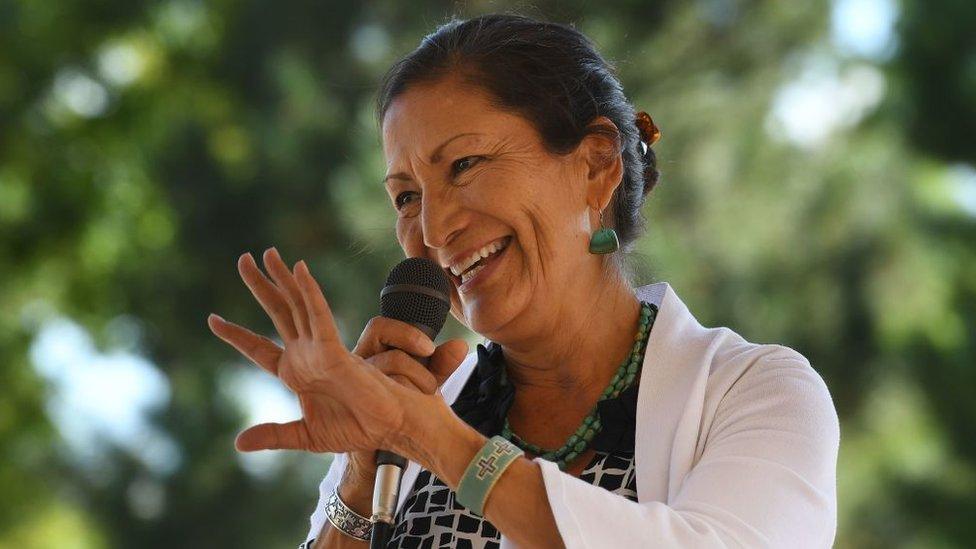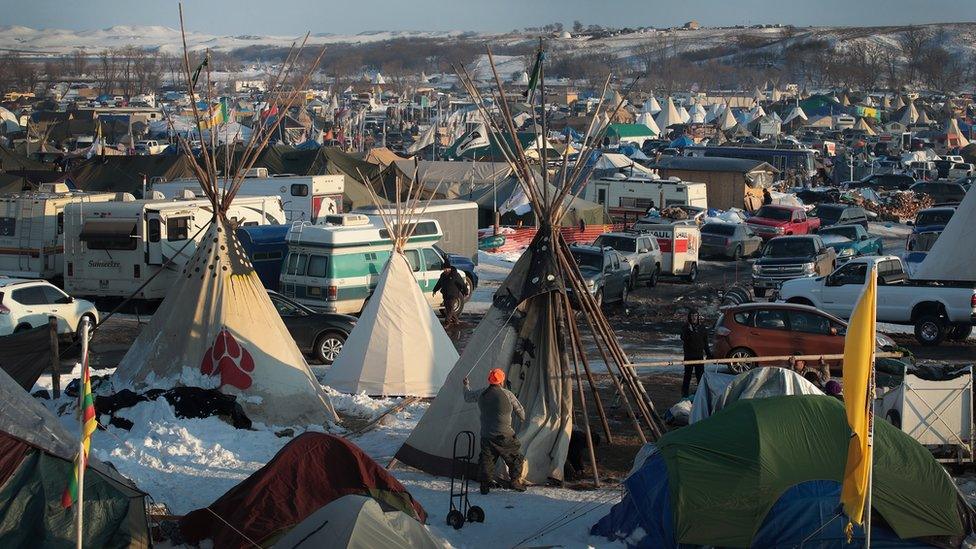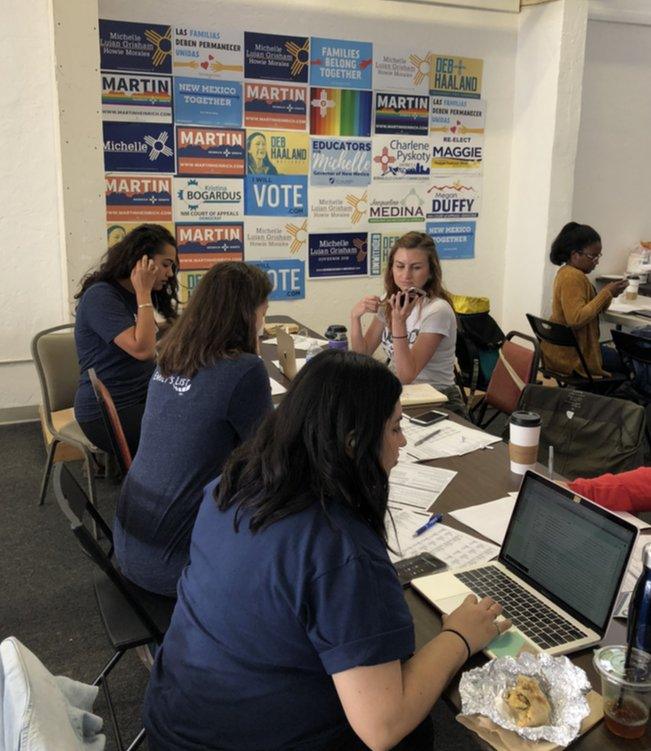Deb Haaland: Why more Native Americans are running for office
- Published

On a stage in Albuquerque's Indian Pueblo Cultural Centre a group of primary school dancers is bobbing to the mesmerising sound of chanting and the monotonous beat of a drum.
The children are dressed in the traditional attire of their people, with enormous feather headdresses, white boots and red belts. In their hands they clasp mini spears and brightly coloured shields depicting eagles, horses and the local desert landscape.
These tiny dancers are celebrating a big moment for their community. Their guest of honour is Deb Haaland, a member of the Laguna Pueblo tribe, who is on the brink of becoming the first Native American woman ever to be elected to the US congress.
Her own struggles as a single mother will be familiar to many Americans regardless of their race - she talks of relying on government food stamps and struggling to pay off student debt.
If she defeats her Republican opponent, Janice Arnold-Jones, as polls and early voting data suggest she will, Ms Haaland wants to use her position to shift New Mexico's economy away from the extraction of oil and gas which, she says, is scarring the landscape and threatening sacred land such as Chaco Canyon, a historic site which sits at the heart of a pre-Columbian civilisation which flourished from the middle of the ninth century AD.
The "Pink Wave": How women are shaping the 2018 US elections
"On my mom's side I'm a 35th generation New Mexican," says Ms Haaland. "My ancestors have been in New Mexico since the late 1200s."
With the arrival of the Spanish in the 16th Century, those ancestors - who lived in compact communities and were therefore known as Pueblo Peoples from the Spanish word for town - entered into an epoch of struggle.
Ms Haaland recalls how even as recently as the mid-20th Century the federal government's Bureau of Indian Affairs tried to indoctrinate native Americans into white, Christian society by compelling them to attend boarding schools where they were forced to renounce their traditional clothing, hairstyle, language and even their own native names.
The objective was to steal land, says Ms Haaland, whose grandmother was sent to an Indian Boarding School more than 100 miles (161km) from her family from the age of eight until she was 13.
"It was traumatising to whole generations of Native Americans," says the candidate who is running as a Democrat for the US House of Representatives in the state's first congressional district.
She is far from alone.

A record number of Native Americans - 104 by one measure - are running for state and federal office this year. Fifty-five are women. More than 75 are Democrats. Together they represent more than 50 of the 573 federally-recognised tribes in the United States.
Two Native American men sit in Congress at present, both Republicans.
Mark Trahant, the editor of digital news site Indian Country Today, has been tracking the increase in Native American candidates and calculates that this year the number is up 80% in congressional races and 300% in contests for state-wide offices such as governor.
Clearly no two candidates are propelled into politics by exactly the same circumstances, but when discussing this phenomenon two factors come up time and again. One has its roots in the frozen plains of North Dakota; the other in the bright lights of Hollywood.
First, Standing Rock, a Native American protest camp against an oil pipeline which ran from 2016 until early 2017. Not since the Sioux successfully defended their land against US General George Custer's 7th cavalry in 1876 at the Battle of the Little Bighorn (known to the tribes involved as the Battle of the Greasy Grass) had native people gathered in such numbers. Deb Haaland was among them.
The protest was suppressed, at times brutally, and ultimately failed to stop oil flowing through the Dakota Access Pipeline (DAPL) but it led to a political awakening for a generation of activists, many of them Native American.

Protests at the Standing Rock Sioux Reservation swelled for more than six months as it grew into a national movement
Now many of the same people in North Dakota feel as if they are under attack again - this time from voter identity legislation which the US Supreme Court allowed to take effect in the state on 9 October, requiring citizens to provide an ID with their name, date of birth and residential street address before they can vote.
According to Gabriel Sanchez, professor of political science at the University of New Mexico, the law may prevent around a third of North Dakota's indigenous voters, some 20,000 people, from casting a ballot because they live on reservations and use post office boxes instead of street addresses for their mail.
Hang on, what ARE the US 'mid-terms'?
Other estimates for the numbers affected vary and Republicans who introduced the law say it is intended to tackle voter fraud.
"It's one of these things where it's so obvious it's painful," says Prof Sanchez. "It's pretty obvious that you're alienating a very specific segment of the population…it took a long period of time to gain the right to vote. And now it feels to them as though that right is being stripped away."
The effect could be momentous. The Republicans have a one seat majority in the US Senate, and North Dakota Democrat Heidi Heitkamp is a top target for Mr Trump's party in Tuesday's mid-term elections.
She won her seat in 2012 by fewer than 3,000 votes with significant Native American support and politicians in the Republican-controlled state legislature began debating the voter ID law almost immediately.
A big last-minute effort is under way to find ways to register North Dakotans, but analysts are split on whether the measure will succeed in suppressing turnout or whether the outrage will drive more people to the polls. Either way the validity of ballots - and therefore the race itself - could end up being decided in court.

Volunteers for Deb Haaland's campaign
The second event which candidates and analysts say galvanised some Native Americans to run for office was the #MeToo movement against the abuse and mistreatment of women in the film industry and beyond.
"Through the centuries women have been oppressed," says Deb Haaland. "We've been beat up and jailed and killed because we wanted the right to vote. We've been paid less than men for centuries." Native American women have particular challenges, she says, including an "epidemic" of "missing and murdered native women".
Ms Haaland has a very good chance of victory, reckons Mark Trahant of Indian Country Today, although she has competition to become the first Native American congresswoman in the former of former mixed martial arts fighter Sharice Davids.
Ms Davids, a member of the Ho Chunk Nation, is also thought to have a decent chance of victory, even though she is running as a Democrat in conservative Kansas.
In a campaign advert which could legitimately and literally be described as punchy, she alludes to her struggles as a gay indigenous woman who was raised by a single mother.
"Truth is, I've had to fight my whole life because of who I am, who I love and where I started," she says in the advert.
Such tough talk feels like a theme this year.
Back in the Albuquerque cultural centre, as the little dancers were being taken home to their beds, Geneve Platero, a Navajo woman, felt as if a turning point has been reached.
"It's a big step forward," she said, although the path had been long and painful.
"The oppression, the damage from one traumatic event, violence on our people. It's been one after another, one after another," Ms Platero added.
"To heal, it's taken this long."